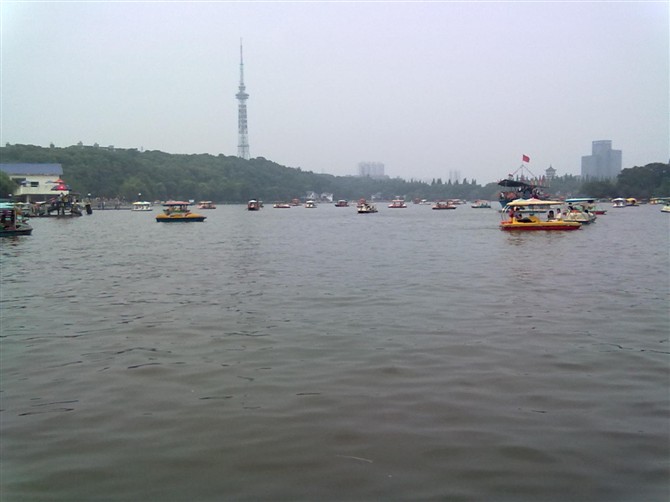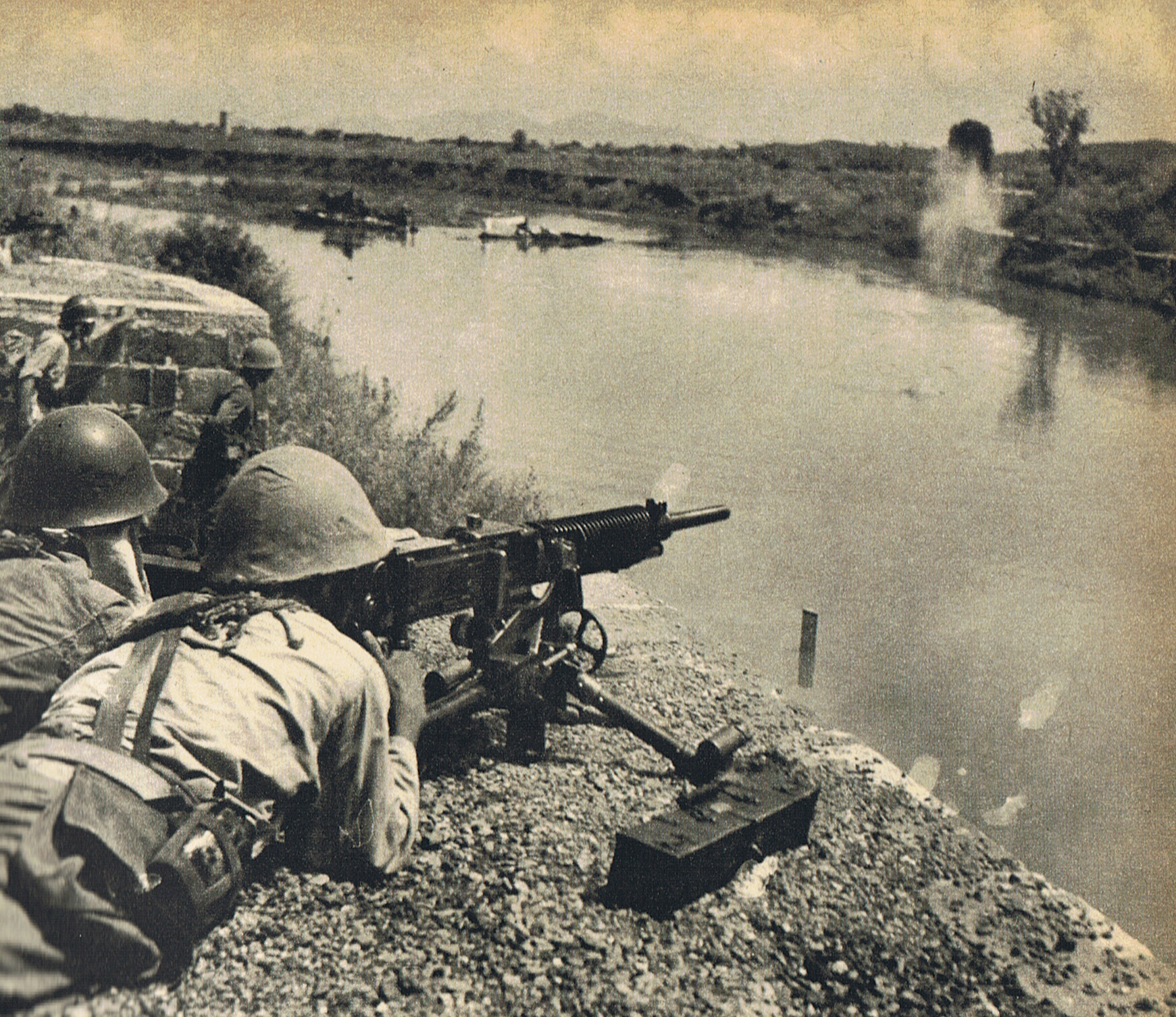|
Hunan Martyr's Park
Hunan Martyr's Park () is an urban park and the largest park in Changsha, Hunan, China. Covering an area of , the park was constructed and opened to the public in 1953. It is a renowned scenic spot integrating memory, leisure and tourism. Hunan Martyr's Park has been designated as a "Provincial Key Cultural Protection Unit" by the Hunan government and a "National Patriotic Education Base" by the Publicity Department of the Communist Party of China. In 2009 it was categorized as a "National Key Park" by the Ministry of Housing and Urban-Rural Development. History Construction began in 1952 and completed in 1953, and opened to the public in May 1956. It covers an area of , of which land area of , and water area of . The Three-Arched Bridge () and Yingfeng Bridge () were established in 1973 and 1982 respectively. In 1983, Hunan Martyr's Park was listed as a "Provincial Key Cultural Protection Unit" by the Hunan government. The Hunan Folk Culture Village () was constructed in 1992 ... [...More Info...] [...Related Items...] OR: [Wikipedia] [Google] [Baidu] |
Public Park
An urban park or metropolitan park, also known as a municipal park (North America) or a public park, public open space, or municipal gardens ( UK), is a park in cities and other incorporated places that offer recreation and green space to residents of, and visitors to, the municipality. The design, operation, and maintenance is usually done by government agencies, typically on the local level, but may occasionally be contracted out to a park conservancy, "friends of" group, or private sector company. Common features of municipal parks include playgrounds, gardens, hiking, running and fitness trails or paths, bridle paths, sports fields and courts, public restrooms, boat ramps, and/or picnic facilities, depending on the budget and natural features available. Park advocates claim that having parks near urban residents, including within a 10-minute walk, provide multiple benefits. History A park is an area of open space provided for recreational use, usually owned and mainta ... [...More Info...] [...Related Items...] OR: [Wikipedia] [Google] [Baidu] |
Mao Zedong
Mao Zedong pronounced ; also romanised traditionally as Mao Tse-tung. (26 December 1893 – 9 September 1976), also known as Chairman Mao, was a Chinese communist revolutionary who was the founder of the People's Republic of China (PRC), which he led as the chairman of the Chinese Communist Party from the establishment of the PRC in 1949 until his death in 1976. Ideologically a Marxist–Leninist, his theories, military strategies, and political policies are collectively known as Maoism. Mao was the son of a prosperous peasant in Shaoshan, Hunan. He supported Chinese nationalism and had an anti-imperialist outlook early in his life, and was particularly influenced by the events of the Xinhai Revolution of 1911 and May Fourth Movement of 1919. He later adopted Marxism–Leninism while working at Peking University as a librarian and became a founding member of the Chinese Communist Party (CCP), leading the Autumn Harvest Uprising in 1927. During the Chinese Civil War ... [...More Info...] [...Related Items...] OR: [Wikipedia] [Google] [Baidu] |
Parks In Hunan
A park is an area of natural, semi-natural or planted space set aside for human enjoyment and recreation or for the protection of wildlife or natural habitats. Urban parks are green spaces set aside for recreation inside towns and cities. National parks and country parks are green spaces used for recreation in the countryside. State parks and provincial parks are administered by sub-national government states and agencies. Parks may consist of grassy areas, rocks, soil and trees, but may also contain buildings and other artifacts such as monuments, fountains or playground structures. Many parks have fields for playing sports such as baseball and football, and paved areas for games such as basketball. Many parks have trails for walking, biking and other activities. Some parks are built adjacent to bodies of water or watercourses and may comprise a beach or boat dock area. Urban parks often have benches for sitting and may contain picnic tables and barbecue grills. The largest ... [...More Info...] [...Related Items...] OR: [Wikipedia] [Google] [Baidu] |
Line 3 (Changsha Metro)
Line 3 of the Changsha Metro () is a rapid transit line in Changsha. The first phase opened on 28 June 2020 with 25 stations. A southern extension called Xihuan line () from Shantang to Xiangtan North railway station is opened on 28 June 2023. Opening timeline Stations Future development A southern extension called Xihuan line () to Xiangtan North railway station in neighbouring Yuhu District of Xiangtan Xiangtan () is a prefecture-level city in east-central Hunan province, south-central China. The hometowns of several founding leaders of the Chinese Communist Party, including Chairman Mao Zedong, President Liu Shaoqi, and Marshal Peng Dehuai, a ... City started construction in 2019, with a planned opening in 2023. The extension is 17.29 km long with 8 stations. In the long-term planning, this extension will be extended northward to Changsha West Railway Station and separated from Line 3 to be operated as its own independent line. References Changsha Metro lines ... [...More Info...] [...Related Items...] OR: [Wikipedia] [Google] [Baidu] |
Liuyang River
The Liuyang River (), also known as Liu River () or Liuwei River (), is a right-bank tributary of Xiang River, the largest tributary of Xiang River in Changsha, Hunan Province, China. The river has a length of with its drainage area of , accounting for 39.47% of the total area of Changsha, with surface water resources of 4,506 million cubic meters, accounting for 41.08% of that (as of 2014). It flows through Liuyang City, Changsha County, Yuhua, Furong and Kaifu Districts, and merges into Xiang River at Xinhe Delta Mouth () of Kaifu District. The Liuyang River flows generally east to west. It rises in the Dawei Mountains () of north Luoxiao Range, its main stream runs through more than 20 towns and townships. The Liuyang River has two source flows which are Daxi River () and Xiaoxi River (), of which Daxi River is the main stream and its upper course. Course Upper Liuyang River: The Daxi River () is the main stream of ''upper courses'' of Liuyang River, it has a length of ... [...More Info...] [...Related Items...] OR: [Wikipedia] [Google] [Baidu] |
Peng Dehuai
Peng Dehuai (; October 24, 1898November 29, 1974) was a prominent Chinese Communist military leader, who served as China's Defense Minister from 1954 to 1959. Peng was born into a poor peasant family, and received several years of primary education before his family's poverty forced him to suspend his education at the age of ten, and to work for several years as a manual laborer. When he was sixteen, Peng became a professional soldier. Over the next ten years Peng served in the armies of several Hunan-based warlord armies, raising himself from the rank of private second class to major. In 1926, Peng's forces joined the Kuomintang, and Peng was first introduced to communism. Peng participated in the Northern Expedition, and supported Wang Jingwei's attempt to form a left-leaning Kuomintang government based in Wuhan. After Wang was defeated, Peng briefly rejoined Chiang Kai-shek's forces before joining the Chinese Communist Party, allying himself with Mao Zedong and Zhu De. Pen ... [...More Info...] [...Related Items...] OR: [Wikipedia] [Google] [Baidu] |
Song Dynasty
The Song dynasty (; ; 960–1279) was an imperial dynasty of China that began in 960 and lasted until 1279. The dynasty was founded by Emperor Taizu of Song following his usurpation of the throne of the Later Zhou. The Song conquered the rest of the Ten Kingdoms, ending the Five Dynasties and Ten Kingdoms period. The Song often came into conflict with the contemporaneous Liao, Western Xia and Jin dynasties in northern China. After retreating to southern China, the Song was eventually conquered by the Mongol-led Yuan dynasty. The dynasty is divided into two periods: Northern Song and Southern Song. During the Northern Song (; 960–1127), the capital was in the northern city of Bianjing (now Kaifeng) and the dynasty controlled most of what is now Eastern China. The Southern Song (; 1127–1279) refers to the period after the Song lost control of its northern half to the Jurchen-led Jin dynasty in the Jin–Song Wars. At that time, the Song court retreated south of the ... [...More Info...] [...Related Items...] OR: [Wikipedia] [Google] [Baidu] |
Hunan Martyrs Park 7
Hunan (, ; ) is a landlocked province of the People's Republic of China, part of the South Central China region. Located in the middle reaches of the Yangtze watershed, it borders the province-level divisions of Hubei to the north, Jiangxi to the east, Guangdong and Guangxi to the south, Guizhou to the west and Chongqing to the northwest. Its capital and largest city is Changsha, which also abuts the Xiang River. Hengyang, Zhuzhou, and Yueyang are among its most populous urban cities. With a population of just over 66 million residing in an area of approximately , it is China's 7th most populous province, the fourth most populous among landlocked provinces, the second most populous in South Central China after Guangdong and the most populous province in Central China. It is the largest province in South-Central China and the fourth largest among landlocked provinces and the 10th most extensive province by area. Hunan's nominal GDP was US$ 724 billion (CNY 4.6 trillion) ... [...More Info...] [...Related Items...] OR: [Wikipedia] [Google] [Baidu] |
Hunan Martyrs Park 2
Hunan (, ; ) is a landlocked Provinces of China, province of the People's Republic of China, part of the South Central China region. Located in the middle reaches of the Yangtze watershed, it borders the Administrative divisions of China, province-level divisions of Hubei to the north, Jiangxi to the east, Guangdong and Guangxi to the south, Guizhou to the west and Chongqing to the northwest. Its capital and largest city is Changsha, which also abuts the Xiang River. Hengyang, Zhuzhou, and Yueyang are among its most populous urban cities. With a population of just over 66 million residing in an area of approximately , it is China's List of Chinese administrative divisions by population, 7th most populous province, the fourth most populous among landlocked provinces, the second most populous in South Central China after Guangdong and the most populous province in Central China. It is the largest province in South Central China, South-Central China and the fourth largest among la ... [...More Info...] [...Related Items...] OR: [Wikipedia] [Google] [Baidu] |





